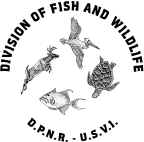

Division of Fish and Wildlife Department of Planning and Natural Resources
Government of the Virgin Islands
Division of Fish and Wildlife Department of Planning and Natural Resources Government of the Virgin Islands |
In 1990 the Legislature of U.S. Virgin Island enacted the Indigenousand Endangered Species Act, (Title 12 Chapter 2) whose purpose is "toprotect, conserve, and manage indigenous fish, wildlife, and plants, andendangered or threatened species for the ultimate benefit of all VirginIslanders, now and in the future". The Division of Fish and Wildlife(DFW) cooperates with the US Fish and Wildlife Service (USFWS) and theNational Marine Fisheries Service (NMFS) to monitor and protect endangered andprotected species. DFW holds a "Full Authorities" Section 6Cooperative Agreement with USFWS, and a "Limited Authorities" Section6 Cooperative Agreement with NMFS. In addition DFW holds a research permit(# 1304, expires 2006) with NMFS to conduct sea turtle research in Territorialwaters. We are also authorized under 109H of the Marine Mammal Protection Act, whichauthorizes Division Biologists to respond to marine mammal strandings. The endangered species program for the U.S. Virgin Islands focuses its attention on Leatherback sea turtles. Sandy Point, which is located on the southwest corner of St. Croix, is the largest leatherback nesting beach in the United States. There are many of other animals and plants in the territory that are under consideration for conservation and management projects when funding becomes available. A list of Endangered Plants and Animals of the U.S.Virgin Islands was compiled in 1991 by the Division of Fish and Wildlife, the UVI Cooperative Extension Service, Eleanor Gibney (Caneel Bay), Gary Ray (U. of Wisconsin) and William Mclean (UVI). This list represents plants and animals occurring in the US Virgin Islands which are protected by either the US Endangered Species Act of 1973 or the VI Endangered and Indigenous Species Act of 1990 (Act No. 5665). This list was promulgated under Act 5665, Section 104(g) and may be revised as new information becomes available. The Endangered Species Coordinator has been working with Territorial andFederal agencies, Non-Government Organizations and privateindividuals to encourage community participation in the conservation, monitoringand management of the Territories endangered and threatened species. TheDivision of Fish and Wildlife works closely with, Virgin Island Network ofEnvironmental (VINE) Educators and (click on the WIMARCS logo to be taken to their web site) to promoteResponsible Resource Use. Annual and other reports on the status of our various endangered species are available here:
In 2006 representatives from the USFWS field office in Boqueron, Puerto Rico visited St. Croix to determine if the plants that the Division of Fish and Wildlife asked to be listed in 1996 should be listed on the Federal Endangered Species list. The plants that were proposed to be listed are the Catesbaea melanocarpa, Agave eggersiana, and the Solanum conocarpum. Please if you see an Agave eggersiana call the Division of Fish and Wildlife to report it. We are looking for additional "wild" populations of this plant. Pictures of these species are presented here (click on individual picture for enlargement):
|
| | Home Page | Mission | Calendar | Offices | Contact Us | |